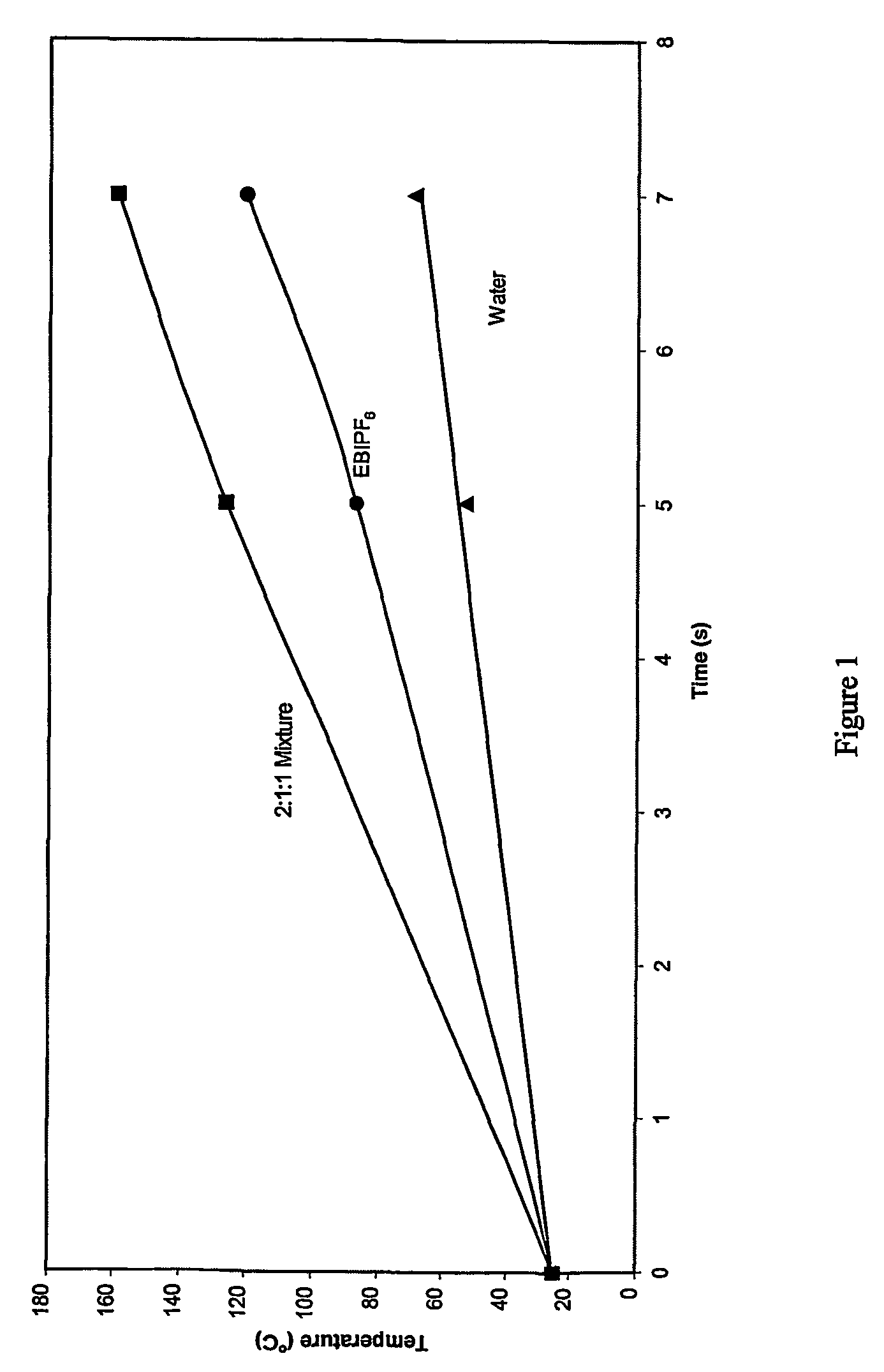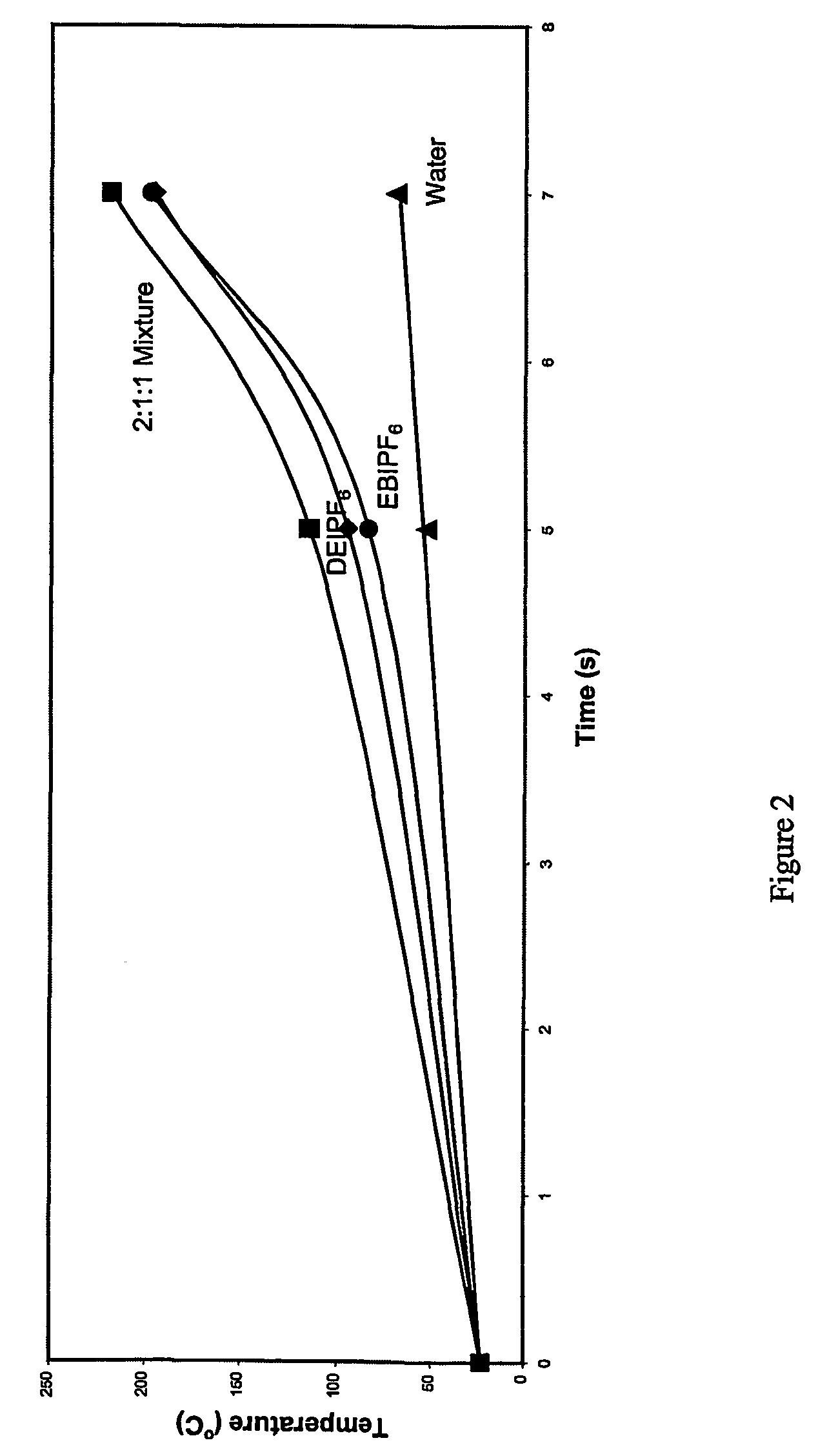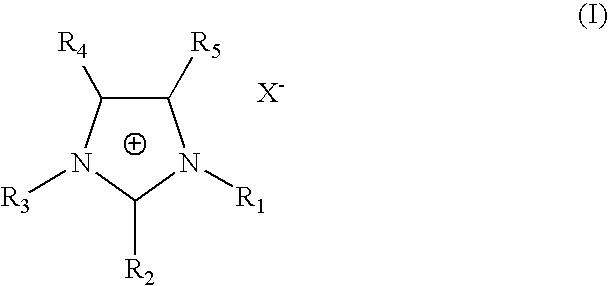One-step process for the preparation of halide-free hydrophobic salts
a technology of hydrophobic salts and hydrophobic halide, which is applied in the field of one-step process for the preparation of halide-free hydrophobic salts, can solve the problems of high cost of alkylimidazole, halide impurities such as clsup>/sup>, brsup>/sup>, and isup>/sup>, and achieves the effect of absorbing microwave radiation
- Summary
- Abstract
- Description
- Claims
- Application Information
AI Technical Summary
Benefits of technology
Problems solved by technology
Method used
Image
Examples
example 1
Preparation of 1,3-Diethylimidazolium Hexafluorophosphate
[0031]Aqueous formaldehyde (15 ml of 37 wt % formaldehyde; 0.20 mol) was magnetically stirred in a 250 ml Erlenmeyer flask immersed in an ice bath. Aqueous ethylamine (32 ml of 70 wt % ethylamine; 0.40 mol) was added in drops to the cold formaldehyde. The solution was stirred 15 minutes and aqueous hexafluorophosphoric acid (30 ml of 60 wt % HPF6; 0.20 mol) was added in small portions from a plastic syringe. A white precipitate formed during the addition, but re-dissolved to give a clear solution, which was stirred ˜15 minutes before aqueous glyoxal (23 ml of 40 wt % glyoxal; 0.20 mol) was added drop-wise. The solution was stirred overnight, during which time the ice bath warmed to room temperature. A white precipitate formed. The mixture was stirred approximately another 30 hours at room temperature and was chilled in the refrigerator. The precipitate was collected by suction filtration, washed with cold water, and dried unde...
example 2
Preparation of 1,3-Diethylimidazolium Hexafluoroarsenate
[0036]Aqueous ethylamine (32 ml of 70 wt % ethylamine; 0.40 mol) was added in drops to ice-cold, magnetically stirred aqueous formaldehyde (15 ml of 37 wt % formaldehyde; 0.20 mol) in a 250 ml Erlenmeyer flask immersed in an ice bath. Aqueous hexafluoroarsenic acid (59 g of 65 wt % AsF6H; 0.20 mol) was added in drops, causing the separation of a white precipitate. The mixture was stirred 10 minutes before the addition of aqueous glyoxal (23 ml of 40 wt % glyoxal; 0.20 mol). The mixture was stirred overnight while the ice bath warmed to room temperature spontaineously. The two-phase reaction mixture consisted of an upper aqueous phase and a golden-yellow, viscous liquid. In the process of decanting the supernatant aqueous layer, the lower viscous liquid phase crystallized exothermically. The crystalline product was collected by suction filtration and washed with water. The product was dissolved in warm methanol and re-crystalliz...
example 3
Preparation of 1,3,4-Trimethylimidazolium Hexafluorophosphate
[0039]Aqueous methylamine (35 ml of 40 wt % methylamine; 0.40 mol) was added in drops to ice-cold, magnetically stirred aqueous formaldehyde (15 ml of 37 wt % formaldehyde; 0.20 mol) in a 250 ml Erlenmeyer flask immersed in an ice bath. After 10 minutes, aqueous hexafluorophosphoric acid (30 ml of 60 wt % HPF6; 0.20 mol) was added in small portions from a plastic syringe. Finally, aqueous pyruvic aldehyde (33 ml of 40 wt % pyruvic aldehyde; 0.20 mol) was added in drops from a pipet. The reaction solution took on the yellow color of the pyruvic aldehyde. The solution was stirred while the ice bath was allowed to warm spontaneously. Within a few hours, a precipitate had formed and the color of the mixture had darkened. The mixture was stirred overnight at room temperature, by which time the mixture was dark red and contained a considerable proportion of solid. The precipitate was collected by suction filtration, washed with ...
PUM
 Login to View More
Login to View More Abstract
Description
Claims
Application Information
 Login to View More
Login to View More - R&D
- Intellectual Property
- Life Sciences
- Materials
- Tech Scout
- Unparalleled Data Quality
- Higher Quality Content
- 60% Fewer Hallucinations
Browse by: Latest US Patents, China's latest patents, Technical Efficacy Thesaurus, Application Domain, Technology Topic, Popular Technical Reports.
© 2025 PatSnap. All rights reserved.Legal|Privacy policy|Modern Slavery Act Transparency Statement|Sitemap|About US| Contact US: help@patsnap.com



